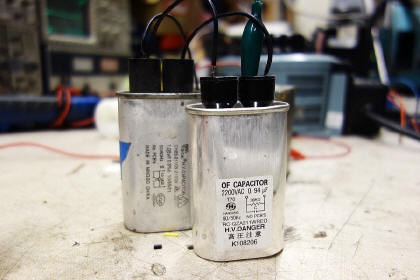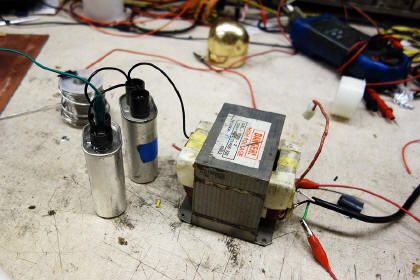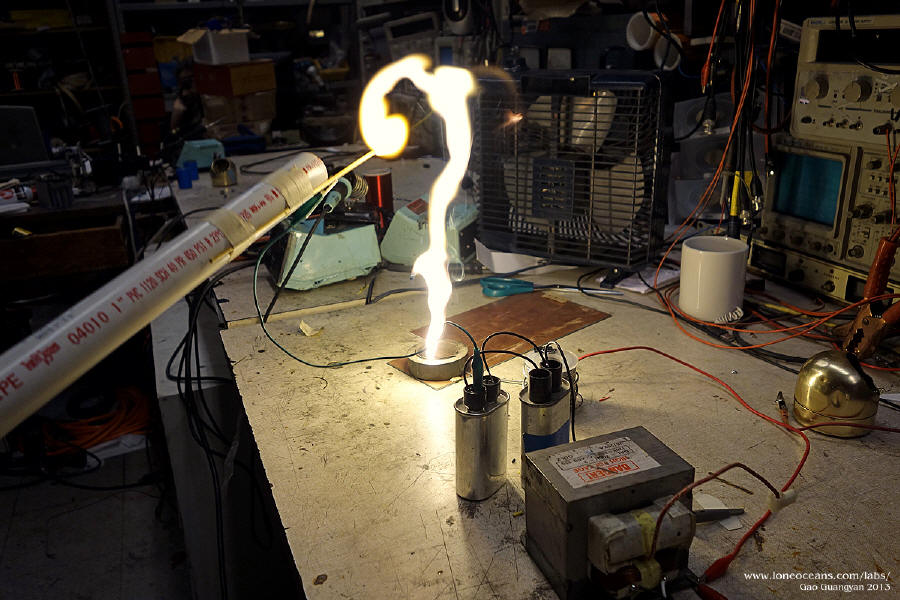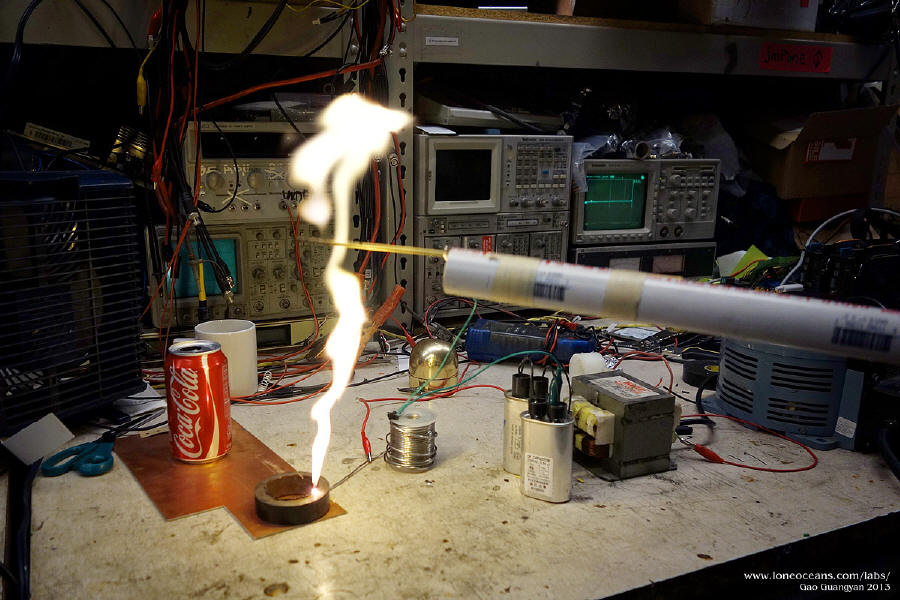Single Resonant MOT
Huge Arcs from a Single Resonant Microwave
Oven Transformer
|
Introduction
The Microwave Oven Transformer is a normal, large, laminated iron core
transformer found in Microwave Ovens. This transformer steps up the 240
or 120VAC voltage from the mains, to about 1800 to 2200VAC for use in
the magnetron (to generate Microwaves). These Microwave Oven
Transformers (MOTs) are very robust and handle 600W (for small ovens) up
to 2000W (for the biggest ovens). These MOTs are also cheaply and easily
found, making them favourite components of High Voltage enthusiasts.
Other useful components inside a Microwave Oven also include the high
voltage capacitor (usually 2kVAC at 1uF) and a high voltage diode.
Here, I present the simplest way to create huge power electrical
arcs using only a single MOT and some Microwave Oven Capacitors.
Warning: The experiment described
here is very dangerous due to the presence of high voltage and
extremely high currents. Any accidental contact with the HV output will
certainly cause severe injury, and can be lethal. Everything you do is
at your own responsibility and risk.
29 Nov 2013
Schematic and Construction
For this experiment, I used a small MOT (probably from a
700W Microwave Oven), as well as two Microwave Oven Capacitors. I also
used a 2kW variac to power the primary of the MOT to allow me to control
power, as well as to provide a small amount of ballasting which would
otherwise trip the mains.
Principle of Operation
A single MOT produces 2kVAC, which is insufficiently
high to jump much of an air cap (about 2mm). However, after a spark is
formed when the outputs are briefly touched, the high current (100mA +)
flowing through the spark quickly heats up the air and ionizes it,
forming a plasma channel which can support even more current. This
creates a huge bright-white flaming arc. When the arc is drawn too long,
the power cannot keep up with the constantly cooling plasma channel.
Eventually, the arc extinguishes. For a single MOT, making arcs longer
than 20cm can be difficult.
However, by adding a series capacitor, we bring the
system into series resonance.
MOTs are designed to have what is known as a large
leakage inductance. When a heavy load is applied on the secondary of
the MOT, instead of dropping to 0 inductance, the MOT core is designed
in such a way for the inductance to drop to this leakage inductance.
Because we are driving the MOT at mains frequency (50 ot 60Hz), we can
calculate the correct capacitance to bring the system into resonance.
The result of this is that much larger currents can be
drawn, as well as resonant rise in output voltage, several kV higher
than we would normally expect! All this results in a arc that has much
more power --> larger, longer, and also more dangerous!
Finding the Resonant Capacitor Size
In order to find the right resonant capacitor size, one
needs to find out what the leakage inductance is. It is generally
challenging to find the inductance without proper equipment. However,
depending on the MOT, experiments have shown that a capacitance of 2 to
3uF on the output generally leads to good results. Thus, one can simply
use Microwave Oven capacitors in parallel, which are perfectly suited
for these task.
Schematic
The schematic is straightforward.

Note that some MOTs have only one secondary output. The
other is tied to the metal body of the MOT. The components are quickly
wired up.


The arc is very hot and powerful - large electrodes must
be used otherwise they will melt!
Additional Work
For even bigger arcs, two MOTs can be used instead, with
the secondary wired in series and a small resonant capacitor (albeit
rated at a higher voltage). For example, two MOTs could have their
primaries wire in parallel (with the phasing checked to be correct) and
secondaries in series. This is then placed in series with a 1uF 4kV
resonant capacitor on the output.
Results
The results are very impressive. A single MOT would create
roughly 20cm arcs at best. With the resonant capacitor, arcs
grow to in excess of half a meter (difficult to capture the
exact moment of maximum length with a camera). The resulting arc
is very hot and very bright, and contains significant UV. Proper
eye protection is very important.

Very impressive flaming arcs which ignite the oxygen in the air
forming plasma blobs even after the arc has extinguished.

At these power levels, the MOT heats up very quickly. The MOT
should only be run for short periods of time.
Links
Here are some useful links to find out more about
resonant MOTs.
Back to main page
(c) Gao Guangyan 2013
Contact: loneoceans [at] gmail [dot] com |

